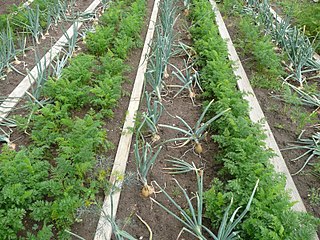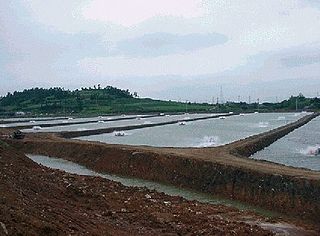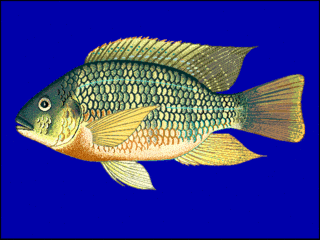
Aquaculture, also known as aquafarming, is the farming of fish, crustaceans, mollusks, aquatic plants, algae, and other organisms. Aquaculture involves cultivating freshwater and saltwater populations under controlled conditions, and can be contrasted with commercial fishing, which is the harvesting of wild fish. Mariculture commonly known as marine farming refers to aquaculture practiced in marine environments and in underwater habitats.

Mariculture is a specialized branch of aquaculture involving the cultivation of marine organisms for food and other products in the open ocean, an enclosed section of the ocean, or in tanks, ponds or raceways which are filled with seawater. It is commonly known as marine farming also. An example of the latter is the farming of marine fish, including finfish and shellfish like prawns, or oysters and seaweed in saltwater ponds. Non-food products produced by mariculture include: fish meal, nutrient agar, jewellery, and cosmetics.

Fish farming or pisciculture involves raising fish commercially in tanks or enclosures such as fish ponds, usually for food. It is the principal form of aquaculture, while other methods may fall under mariculture. A facility that releases juvenile fish into the wild for recreational fishing or to supplement a species' natural numbers is generally referred to as a fish hatchery. Worldwide, the most important fish species produced in fish farming are carp, tilapia, salmon, and catfish.

Polyculture is a form of agriculture in which more than one species is grown at the same time and place in imitation of the diversity of natural ecosystems. Polyculture is the opposite of monoculture, in which only members of one plant or animal species are cultivated together. Polyculture has traditionally been the most prevalent form of agriculture in most parts of the world and is growing in popularity today due to its environmental and health benefits. There are many types of polyculture including annual polycultures such as intercropping and cover cropping, permaculture, and integrated aquaculture. Polyculture is advantageous because of its ability to control pests, weeds, and disease without major chemical inputs. As such, polyculture is considered a sustainable form of agriculture. However, issues with crop yield and biological competition have caused many modern major industrial food producers to continue to rely on monoculture instead.

Charoen Pokphand Foods Public Company Limited a company of the Charoen Pokphand Group, is an agro-industrial and food conglomerate headquartered in Thailand. It is the world's largest producer of feed and shrimp, and is also a global top three producer of poultry and pork.

Marine shrimp farming is an aquaculture business for the cultivation of marine shrimp or prawns for human consumption. Although traditional shrimp farming has been carried out in Asia for centuries, large-scale commercial shrimp farming began in the 1970s, and production grew steeply, particularly to match the market demands of the United States, Japan and Western Europe. The total global production of farmed shrimp reached more than 1.6 million tonnes in 2003, representing a value of nearly 9 billion U.S. dollars. About 75% of farmed shrimp is produced in Asia, in particular in China and Thailand. The other 25% is produced mainly in Latin America, where Brazil, Ecuador, and Mexico are the largest producers. The largest exporting nation is India.

A fish hatchery is a place for artificial breeding, hatching, and rearing through the early life stages of animals—finfish and shellfish in particular. Hatcheries produce larval and juvenile fish, shellfish, and crustaceans, primarily to support the aquaculture industry where they are transferred to on-growing systems, such as fish farms, to reach harvest size. Some species that are commonly raised in hatcheries include Pacific oysters, shrimp, Indian prawns, salmon, tilapia and scallops. The value of global aquaculture production is estimated to be US$98.4 billion in 2008 with China significantly dominating the market; however, the value of aquaculture hatchery and nursery production has yet to be estimated. Additional hatchery production for small-scale domestic uses, which is particularly prevalent in South-East Asia or for conservation programmes, has also yet to be quantified.

Tilapia has become the third most important fish in aquaculture after carp and salmon; worldwide production exceeded 1.5 million metric tons in 2002 and increases annually. Because of their high protein content, large size, rapid growth, and palatability, a number of coptodonine and oreochromine cichlids—specifically, various species of Coptodon, Oreochromis, and Sarotherodon—are the focus of major aquaculture efforts.

Integrated multi-trophic aquaculture (IMTA) provides the byproducts, including waste, from one aquatic species as inputs for another. Farmers combine fed aquaculture with inorganic extractive and organic extractive aquaculture to create balanced systems for environment remediation (biomitigation), economic stability and social acceptability.

Fishing in India is a major industry employing 145 million people. India ranks second in aquaculture and third in fisheries production. Fisheries contributes to 1.07% of the Total GDP of India. According to the National Fisheries Development Board the Fisheries Industry generates an export earnings of Rs 334.41 billion. Centrally sponsored schemes will increase exports by Rs 1 lakh crore in FY25. 65,000 fishermen have been trained under these schemes since year 2017 to year 2020. Freshwater consists 55% of total fish production.
The Marine Institute is a State agency in Ireland that provdes government, public agencies and the maritime industry with a range of scientific, advisory and economic development services, aiming to inform policy-making, regulation and the sustainable management and growth of the country’s marine resources. Founded in 1991 on foot of a 1974 report, the Institute undertakes, coordinates and promotes marine research and development, which is essential to achieving a sustainable ocean economy, protecting ecosystems and inspiring a shared understanding of the ocean. The agency is governed by a ministerially-appointed board and has a professional staff, a headquarters near Galway, an office in Dublin, and two research vessels.
Skretting is the world's largest producer of feeds for farmed fish.

Fishery and fishing industry plays a significant part in the national economy of Pakistan. With a coastline of about 814 km, Pakistan has enough fishery resources that remain to be developed. Most of the population of the coastal areas of Sindh and Balochistan depends on fisheries for livelihood. It is also a major source of export earning.
Organic aquaculture is a holistic method for farming marine species in line with organic principles. The ideals of this practice established sustainable marine environments with consideration for naturally occurring ecosystems, use of pesticides, and the treatment of aquatic life. Managing aquaculture organically has become more popular since consumers are concerned about the harmful impacts of aquaculture on themselves and the environment.

Manufactured feeds are an important part of modern commercial aquaculture, providing the balanced nutrition needed by farmed fish. The feeds, in the form of granules or pellets, provide the nutrition in a stable and concentrated form, enabling the fish to feed efficiently and grow to their full potential.

Offshore aquaculture, also known as open ocean aquaculture, is an emerging approach to mariculture or marine farming where fish farms are moved some distance offshore. The farms are positioned in deeper and less sheltered waters, where ocean currents are stronger than they are inshore. Existing ‘offshore’ developments fall mainly into the category of exposed areas rather than fully offshore. As maritime classification society, DNV GL, has stated, development and knowledge-building are needed in several fields for the available deeper water opportunities to be realized.
Saltwater aquaponics is a combination of plant cultivation and fish rearing, systems with similarities to standard aquaponics, except that it uses saltwater instead of the more commonly used freshwater. In some instances, this may be diluted saltwater. The concept is being researched as a sustainable way to eliminate the stresses that are put on local environments by conventional fish farming practices who expel wastewater into the coastal zones, all while creating complementary crops.
Aquaculture started to take off in Madagascar in the 1980s. The majority of Aquaculture in Madagascar includes the cultivation of sea cucumbers, seaweed, fish and shrimp. Aquaculture in Madagascar is being used to stimulate the countries economy, increase the wages of fishermen and women in the area and improve the regions ocean water quality. Coastal regions of Madagascar are reliant on the Indian Oceans marine resources as a source of food, income, and cultural identity.
Central Institute of Brackishwater Aquaculture (CIBA) is one of the research institutes under Indian Council of Agricultural Research (ICAR), New Delhi to serve as the nodal agency for catering to the needs of the brackishwater aquaculture research in India. The institute is headquartered at Santhome High Road, Raja Annamalai Puram, Chennai with a research centre at Kakdwip in West Bengal and an experimental field station at Muttukadu, roughly 30 km to the south of Chennai. The institute works under the Ministry of Agriculture, India.
The Fishing industry in Thailand, in accordance with usage by The World Bank, the UN's Food and Agriculture Organization (FAO) and other multinational bodies, refers to and encompasses recreational fishing, aquaculture, and wild fisheries both onshore and offshore.












